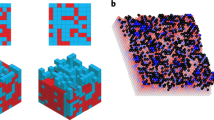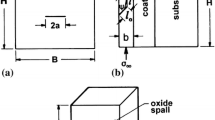Abstract
Heat-resistant alloys used in mixed-oxidant environments rely on the formation of a chromia, alumina, or silica surface film for corrosion resistance and the presence of second-phase precipitates in the matrix often for their strength properties. The growth of the oxide film on such alloys is often accompanied by the dissolution of precipitates in the alloy subsurface region. Continued oxidation combined with oxide-scale spallation tends to decrease the content of the oxide-forming constituent to such a level that protective scaling can no longer occur and severe degradation can develop. In the present work, the initial corrosion processes involving the complex coupling between oxide scale growth and precipitate dissolution is simulated computationally. As an example, a Ni-Cr alloy containing Cr 23 C 6 precipitates was exposed to an oxidizing-carburizing environment. An approach combining finite difference and Newton-Raphson methodologies is developed to model this diffusion/ dissolution process, incorporating the point-defect-chemistry aspects of the oxide scale. The model is able to predict the chemical and microstructural evolution of high-chromium austenitic alloys during the initial stages of oxidation-carburization.
Similar content being viewed by others
References
J. Nowotny, ed.,Diffusion in Solids and High Temperature Oxidation of Metals (Trans Tech, Zürich, 1992).
R. Petkovic-Luton and T. A. Ramanarayanan,Oxid. Met. 34, 381–399 (1990).
F. S. Pettit, J. A. Goebel, and G. W. Goward,Corros. Sci. 9, 303 (1969).
A. Rahmel,Corros. Sci. 13, 125 (1973).
J. A. Colwell and R. A. Rapp,Met. Trans. A 17A, 1065 (1986).
C. Wagner, Diffusion and high temperature oxidation of metals, inAtom Movements (American Society for Metals, Cleveland, 1951), pp. 153–173.
K. Hauffe,Oxidation of Metals (Plenum, New York, 1965).
T. A. Ramanarayanan and R. Petkovic-Luton,Ber. Bunsenges. Phys. Chem. 89, 402–09 (1985).
P. Shewmon,Diffusion in Solids, 2nd Ed., Chap. 1: Diffusion Equations (TMS, Warrendale, 1989), pp. 9–51.
F. B. Hildebrand,Advanced Calculus for Applications, Chap. 7: Topics in Higher-Dimensional Calculus (Prentice-Hall, Englewood Cliffs, 1976), pp. 367–370.
W. H. Press, B. P. Flannery, S. A. Teukolsky, and W. T. Vetterling,Numerical Recipes, Chap. 9: Root Finding and Nonlinear Sets of Equations (Cambridge Univ., New York, 1986), p. 254.
G. D. Smith,Numerical Solution of Partial Differential Equations, Chap. 2: Parabolic Equations; Finite Difference Methods (Clarendon, Oxford, 1985) pp. 11–110.
W. H. Press, B. P. Flannery, S. A. Teukolsky, and W. T. Vetterling,Numerical Recipes, Chap. 17: Partial Differential Equations (Cambridge Univ., New York, 1986), p. 615.
C. Wagner,Z. Physik. Chem. B21, 25 (1933).
P. Kofstad and K. P. Lillerud,J. Electrochem. Soc. 127, 2410 (1980).
P. Kofstad,Nonstoichiometry, Diffusion, and Electrical Conductivity in Binary Metal Oxides, Chap. 5: Diffusion and Electrical Conductivity (Wiley, New York, 1972), pp. 68–95.
P. Shewmon,Diffusion in Solids, 2nd Ed., Chap. 5: Diffusion in Nonmetals (TMS, Warrendale, 1989), pp. 151–187.
P. Shewmon,Diffusion in Solids, 2nd Ed., Chap. 2: Atomic Theory of Diffusion (TMS, Warrendale, 1989), pp. 53–96.
F. N. Mazandarany and R. D. Pehlke,J. Electrochem. Soc. 121, 711 (1974).
R. C. Weast and M. J. Astle, eds.,CRC Handbook of Chemistry and Physics (CRC Press, Boca Raton, 1981).
E. A. Brandes, ed.,Smithell's Metals Reference Book, 6th ed., Chap. 13: Diffusion in Metals (Butterworths, Boston, 1983) pp. 13–60.
R. P. Smith,Trans. Metall. Soc. AIME 236, 1224–1227 (1966).
F. N. Mazandarany and R. D. Pehlke,Metall. Trans. 4, 2067 (1973).
K. Bongartz, D. F. Lupton, and H. Schuster,Metall. Tran. A. 11A, 1883–1893 (1980).
Author information
Authors and Affiliations
Rights and permissions
About this article
Cite this article
Ling, S., Ramanarayanan, T.A. & Petkovic-Luton, R. Computational modeling of mixed oxidation-carburization processes: Part 1. Oxid Met 40, 179–196 (1993). https://doi.org/10.1007/BF00665264
Received:
Revised:
Issue Date:
DOI: https://doi.org/10.1007/BF00665264




